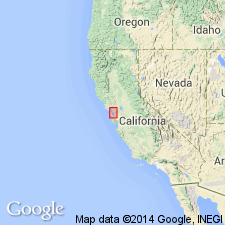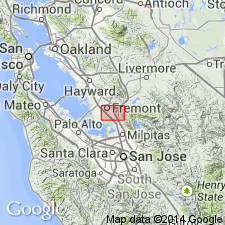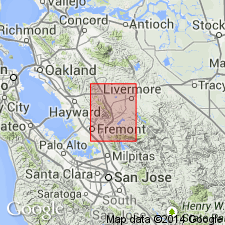
- Usage in publication:
-
- [Irvington beds]
- Modifications:
-
- [Areal extent]
- AAPG geologic province:
-
- Northern Coast Range province
Summary:
Pg. 81. Southeast of Irvington, on east side of bay, a deposit of older alluvium has been cut and its eastern part elevated along a fault. Subsequent erosion has exposed gravels which have been excavated for commercial use. These Irvington beds have yielded a mammalian fauna considered to be [early] Pleistocene in age.
Source: US geologic names lexicon (USGS Bull. 1200, p. 1887-1888).

- Usage in publication:
-
- Irvington gravels
- Irvington deposits
- Modifications:
-
- [First used]
- AAPG geologic province:
-
- Northern Coast Range province
Summary:
Pg. 219-224, 289. Terms Irvington gravels and Irvington deposits are used in this report [Late Cenozoic vertebrates, San Francisco Bay area], but terms are not formally defined. Irvington fauna was described from these gravels, and Irvingtonian stage was proposed for time of deposition of these rocks.
Source: US geologic names lexicon (USGS Bull. 1200, p. 1887-1888).

- Usage in publication:
-
- Irvington gravels
- Modifications:
-
- [Original reference]
- Dominant lithology:
-
- Gravel
- AAPG geologic province:
-
- Northern Coast Range province
Summary:
Pg. 31-33, fig. 2, geol. map. No formal naming of the formation (Irvington gravels) or type locality has been given in any publication. Savage (1951) used term Irvington gravels repeatedly throughout his report on Cenozoic vertebrates of San Francisco Bay region, and he is here considered to have named the unit. These gravels have heen referred to as Santa Clara gravels by previous workers. Irvington gravels composed of cross-bedded stream and, possibly in part, lake deposits. Dips 20 deg. to 25 deg. to the north or northeast. Unconformably overlies Briones sandstone. General appearance of formation is much like that of Livermore gravels, but mountain ridge separates Irvington and Livermore gravels; hence, the two units are separately mapped. Savage regarded Irvington fauna as "earlier Pleistocene" or post-Blancan, pre-Rancholabrean. Irvingtonian stage proposed by Savage (1951) for time of deposition of these rocks is [early] Pleistocene in age.
Source: US geologic names lexicon (USGS Bull. 1200, p. 1887-1888).
For more information, please contact Nancy Stamm, Geologic Names Committee Secretary.
Asterisk (*) indicates published by U.S. Geological Survey authors.
"No current usage" (†) implies that a name has been abandoned or has fallen into disuse. Former usage and, if known, replacement name given in parentheses ( ).
Slash (/) indicates name conflicts with nomenclatural guidelines (CSN, 1933; ACSN, 1961, 1970; NACSN, 1983, 2005, 2021). May be explained within brackets ([ ]).

